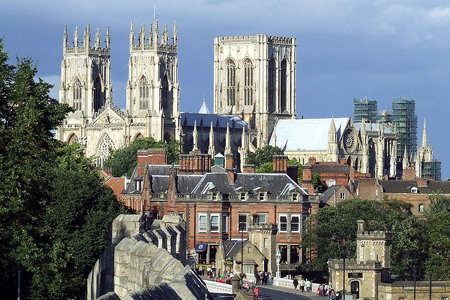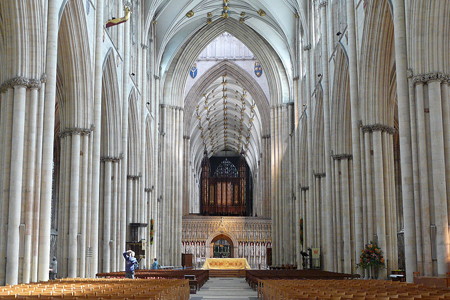| |
 |
 |
 |
| Comment on this report, or find other reports. |
 |
| Our Mystery Worshippers are volunteers who warm church pews for us around the world. If you'd like to become a Mystery Worshipper, start here. |
 |
| Find out how to reproduce this report in your church magazine or website. |
|
|
| 1788: York
Minster, York, England |
 |

Photo: Krystian Hasterok |
 |
Mystery Worshipper:
Mordecai.
The church:
Cathedral
and Metropolitical Church of St Peter, York, England.
Denomination:
Church of England, Diocese
of York.
The building:
In a word, HUGE! It dominates the skyline at York. Damaged,
redesigned, rebuilt and repaired countless times, the present
minster is the largest medieval Gothic cathedral in northern
Europe and an architectural delight. The north and south transepts
differ in design and are separated by a lantern tower. In the
north transept is a memorial to women, the Five Sisters window,
said to be the largest lancet window in the world. In the west
wing is a window known as the Monkeys' Funeral, depicting a
procession of monkeys carrying a coffin, with the border occupied
by a fox stealing a chicken, a dog chasing a stag, a cockerel
reading a lesson, and various other animals. The window is thought
by some to be a parody of the Dormition of Mary, but by others
to signify that just as animals mimic man, so must man mimic
the divine.
The church:
York Minster is the seat of the Archbishop of York, but is also
an active worship community. Most services are open to the public,
although some special events are ticket-only. The Minster conducts
regular pilgrimages to the shrine of Our Lady of Walsingham,
offers a rich series of courses and lectures, operates a Sunday
school, and maintains an active pastoral care and counseling
program, among other ministries.
The neighbourhood:
The ancient Celts called this place Eborakon, meaning "place
of the yew trees," and the Romans Latinised the name to
Eboracum. The Angles and the Vikings gave the name their own
spin, and by the 13th century the name York had evolved. During
the Middle Ages, York became known as the ecclesiastical capital
of northern England. In addition to its prominence in the Anglican
church, York today boasts significant Roman Catholic, Quaker,
Methodist and Unitarian presences. The cathedral is surrounded
by space: the Minster gardens on one side, and a wide paved
area around with other medieval buildings close by.
The cast:
The Revd Canon Glyn Webster, canon chancellor, presided. The
preacher was the Very Revd Keith Jones, dean.
The date & time:
Sunday, 9 August 2009, 10.00am.
What was the name of the service?
Sung Eucharist.
How full was the building?
I was surprised to see a congregation of 250 to 300, which took
up about half the seats in the nave.
Did anyone welcome you personally?
Yes. The greeters on the door were very friendly. First, they
asked us very nicely if we were there for the service, as the
Minster is closed to the public whilst services are in progress.
They then said that we would find service sheets on the chairs.
An announcement was made that because of the swine flu epidemic,
the congregation should limit itself to verbal greetings during
the exchange of peace. A number of people did turn to us and
smile as they wished us peace.
Was your pew comfortable?
Yes. The chairs were quite comfortably padded. The backs of
the chairs had a small ledge to balance your books on.
How would you describe the pre-service
atmosphere?
Reasonable. The organ was playing and there was a certain amount
of noise as people spoke to each other.
What were the exact opening words of the
service?
"Good morning, everybody. Welcome to our eucharist."
What books did the congregation use during the
service?
On each seat was a New English Hymnal, a booklet entitled
York Minster Eucharist, a notice sheet for the week
which included details of the services, a Gift Aid envelope,
and a kneeler.
What musical instruments
were played?
Organ only, but nothing else was necessary! The guest choir
were the Cathedral Singers of Ontario, Canada, who were on a
tour of Britain.
Did anything distract
you?
A certain amount of movement, e.g. a young child running down
the side aisle being chased by its mother. Otherwise just the
amazing building itself.

Photo: Mattana
Was the worship stiff-upper-lip, happy clappy, or
what?
Very formal, but enjoyable. The congregation took part in singing
the hymns, so it didn't come across as a performance where the
congregation were simply an audience.
Exactly how long was the sermon?
11 minutes.
On a scale of 1-10, how good was the preacher?
8 – Very erudite but well pitched; simple but not condescending.
In a nutshell, what was the sermon
about?
The dean spoke about Jesus being unrecognised in his own area,
and that success is only recognised locally when it becomes
a source of local pride. He felt there was a culture of discouragement,
to despise attainment. The "spirit of Nazareth" was that Jesus'
neighbours only saw the son of Mary and Joseph, whereas Jesus
spoke of himself as being a divine presence in this world that
he wanted others to share. We need to look for the heavenly
in the ordinary.
Which part of the service was like being in
heaven?
The singing – the choir singing the Gloria and the Sanctus,
and the congregational singing with the amazing noise of the
organ – real surround sound! It felt like you were caught up
in the sound, at least partly because of the echo and acoustics
of the building.
And which part was like being in... er... the other place?
The acoustics and echo worked for the singing, but they didn't
work for the preaching. You had really to concentrate in order
to hear what the preacher was saying.
What happened when you hung around after the service looking lost?
There had been an announcement that there was coffee in the
chapter house, with the comment that if anyone didn't know where
that was, they should follow the crowds – which we did.
I have a very unusual mobility scooter, and one of the ladies
of the congregation stopped and asked about it, as did a member
of the choir.
How would you describe the after-service
coffee?
The coffee came in plastic cups in holders, served from three or four trestle tables. Biscuits were in a basket at each point. I don't know if the coffee was fair trade, but it tasted quite reasonable.
How would you feel about making this church your regular (where 10 = ecstatic, 0 = terminal)?
7 – I would go back to services at the Minster, but I'm
used to something rather more intimate. I like the fact that
I know just about everyone in my usual church back home, and
I think it would be difficult to do that in the Minster congregation.
Did the service make you feel glad to be a
Christian?
Yes. There was a sense of being part of something huge and awesome.
What one thing will you remember about all this in seven days' time?
The amazing singing. |
|
|
 |
 |
 |
| We rely on voluntary donations to stay online. If you're a regular visitor to Ship of Fools, please consider supporting us. |
 |
 |
 |
| The Mystery Pilgrim |
 |
| One of our most seasoned reporters makes the Camino pilgrimage to Santiago de Compostela in Spain. Read here. |
 |
 |
 |
| London churches |
 |
| Read reports from 70 London churches, visited by a small army of Mystery Worshippers on one single Sunday. Read here. |
| |
|
|
|
|


